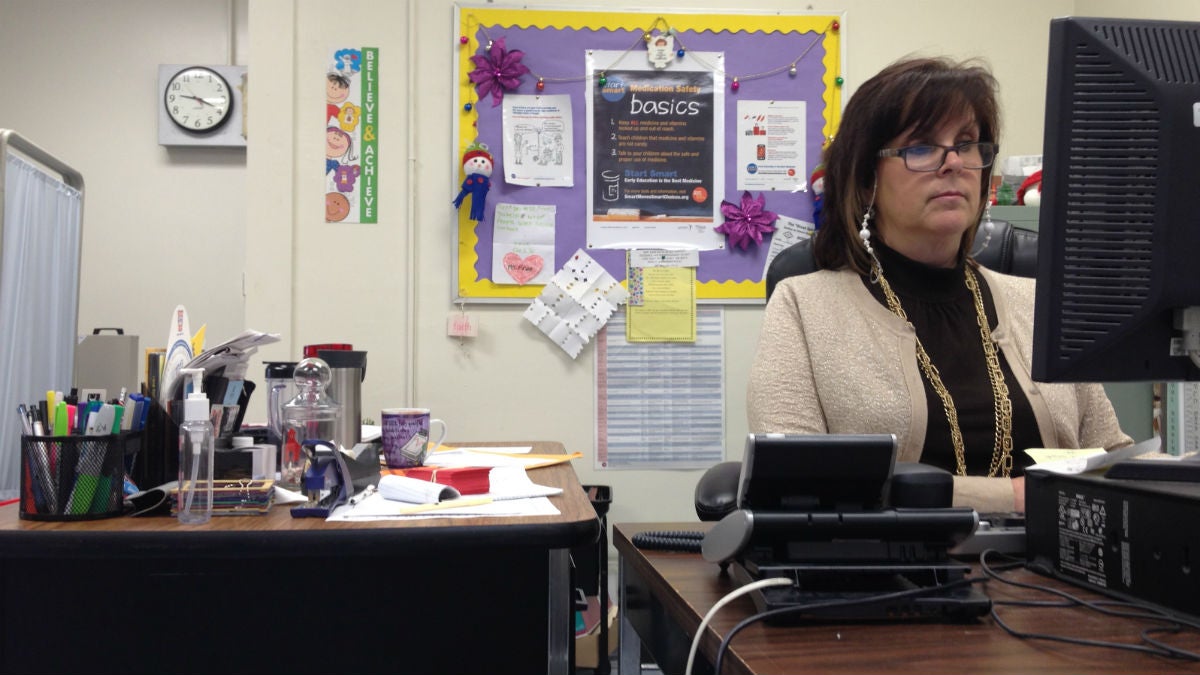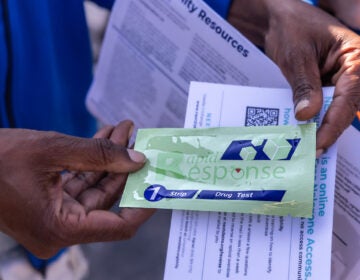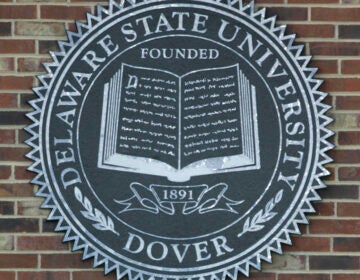Anti-drug message has a new messenger: Delaware’s school nurses
Listen
Fran Avena (above) works from her office at Warner Elementary School. The posters behind her come from the Smart Moves
With prescription pill abuse on the rise, Delaware’s school nurses look to turn the tide.
Laurie Hackett is nervous.
She’s about to stand before the entire eighth grade at Louis L. Redding Middle School in Middletown, Delaware to preach the dangers of drug use. And if addressing a throng of tweens isn’t mortifying enough, there’s this: She’s never led an assembly before.
“It’s my first one,” she says with a smile.
The content of the assembly should sound familiar to those who’ve encountered school-based drug education. There will be scary statistics, moving testimony, and pleas to reach out for help. The novelty here is Hackett. She isn’t a gym teacher. She isn’t a health educator. She isn’t a cop.
She’s the school nurse.
Hackett is MC-ing the event because today’s assembly focuses on prescription medication. It’s an area nurses know well. And with addiction to painkillers and opioids on the rise, school nurses are embracing a new role–that of anti-drug educator.
Hackett’s assembly is the under the aegis of Smart Moves, Smart Choices, a prescription pill education program launched jointly in 2009 by the National Association of School Nurses (NASN) and the drug giant Janssen Pharmaceuticals.
Drug education in schools dates back more than a century. Temperance advocates visited classrooms in the late 19th century to preach the ills of alcohol and tobacco. In recent decades the focus has been on illicit drugs, and police have played a significant role through programs like D.A.R.E. Now as the conversation shifts to prescription drugs, school nurses are stepping into the fray.
“We saw what was happening and the drugs that were being prescribed and how kids were taking them,” says Elizabeth Mattey, a school nurse from North Wilmington and NASN’s president. “They thought one is good. I’ll take three.”
Since 2014, Delaware–the only state that requires every school to have a nurse, according to Mattey–has received $50,000 annually from the state to spread the Smart Moves, Smart Choices gospel. It’s the First State’s attempt to help halt a national epidemic.
In 2012, doctors wrote 259 million prescriptions for painkillers, according to the CDC, enough for every adult American to have his or her own bottle. Between 1999 and 2010, sales of opioid pain relievers quadrupled. So too has the number of unintended deaths linked to prescription pills.
The galling statistics extend to Delaware.
Between 2011 and 2014, the number of adults admitted to state-run substance abuse clinics who listed heroin as their primary drug more than doubled. Heroin acts in much the same way as prescription opioids, and can be a cheaper alternative for pill addicts who’ve run short on funds. Many experts draw a direct link between the proliferation of painkillers and the uptick in heroin addiction.
Fran Avena has seen much of this evolve first-hand. She’s been a nurse since the late 1970s, and spent almost 16 years in the emergency room at Wilmington Hospital beginning in the late 1990s.
She first saw a change in the medical establishment–how E.R. patients traditionally treated with tynenol or ice were gradually prescribed more painkillers. Then she saw a change in the patients.
“You just kinda notice the same people coming in and out and being treated the same,” she says. “It just started clicking over those few years that they weren’t really in so much pain. It had become a problem of substance abuse disorder. The bodies needed it more and more and more.”
Avena now works part-time at the hospital and spends the rest of her time at Warner Elementary School in Wilmington, where she’s the school nurse. When students come into her office for medication, she often greets them with a pop quiz.
“Do you ever take medicine from somebody you don’t know,” she asks a pair of rambunctious third-graders.
“No,” they reply in enthusiastic unison.
“Do you always make sure you check the bottle before you take your medicine,” she says.
“Yeah!”
“Because a stranger would give you the wrong medicine,” explains one of the boys.
This little back-and-forth is inspired by Smart Moves, Smart Choices, which in 2014 introduced an elementary school component. The message for these young students isn’t really anti-drug. It’s more about orienting youngsters in a world that is increasingly medicated.
What’s safe? What isn’t? What does a healthy relationship with prescribed medicine look like for an 8-year-old?
“It’s not just about the opioids and the painkillers. It is about the ADHD medications. It is about the mood disorder medications,” says Avena. “And it’s at all ages. I have preschoolers who are taking medication for various reasons.”
More than a quarter of teens believe it’s safer to misuse or abuse prescription medication than it is to use illicit drugs, according to a 2013 survey by the Partnership for Drug Free Kids. Avena believes nurses are ideally positioned to change that statistic by changing the way young people, even elementary school students, relate to prescription drugs.
She also feels a personal responsibility to help right the wrongs caused by decades of over-prescription.
“Although there’s been some horrific results of this epidemic, there’s been some goodness coming out of it to see the role we all play in this,” says Avena. “It’s been a bittersweet road.”
WHYY is your source for fact-based, in-depth journalism and information. As a nonprofit organization, we rely on financial support from readers like you. Please give today.





